The Chinchero to Urquillos hike in Peru is a great option for anyone staying in the Urubamba valley, or those on a day trip from Cusco. It’s tucked away far from the crowds, and the only other people you’re likely to encounter on the trail are a couple of locals tending their land or their livestock. The hiking trail from Chinchero to Urquillos is actually an old Inca trail, and one that few other visitors ever get to explore.
This half day hike gives an intriguing insight into the complex Inca trail network that radiated out across Peru, joining settlements together in places as far away as Quito in Ecuador, and Santiago in Chile. When people talk of the “Inca Trail” they are usually referring to the famous trek that culminates at Machu Picchu. Yet there are hundreds of Inca trails across the country, and many of them are just as rewarding and beautiful as the one that features in all the travel guides.
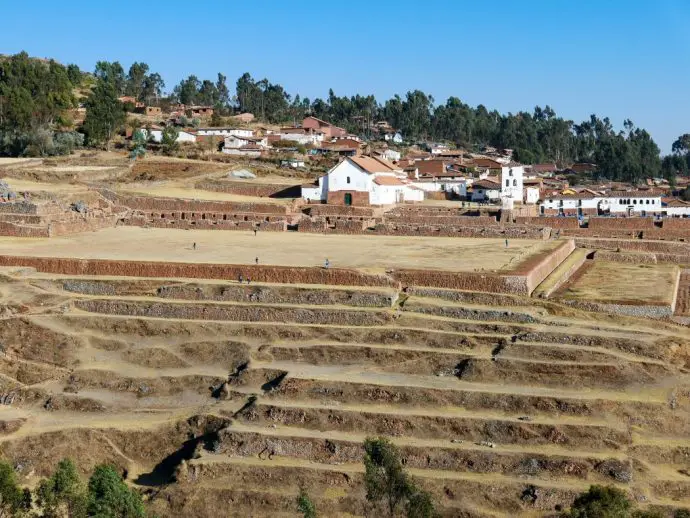
Hiking along this ancient mountain path you’ll enjoy dramatic scenery in one of the steepest valleys in South America, as well walking past the impressive Chinchero ruins and archaeological terraces. It’s peaceful and beautiful, and one of the best adventures in the Sacred Valley. Peru is full of surprises, and this is one we just have to share.
Here’s all you need to know about hiking the Chinchero to Urquillos trail, and why you should include this on your Sacred Valley itinerary.
Table of Contents
Where is Chinchero?
The Andean village of Chinchero lies just off the main road that links Cusco with Urubamba in the Sacred Valley. You can visit on a day tour from Cusco if you’re not staying more locally in the valley.
It takes around half an hour to travel north to Chinchero from Cusco (it’s about 19 miles away), and the views along the route are superb so you’ll probably want to keep stopping for photos!
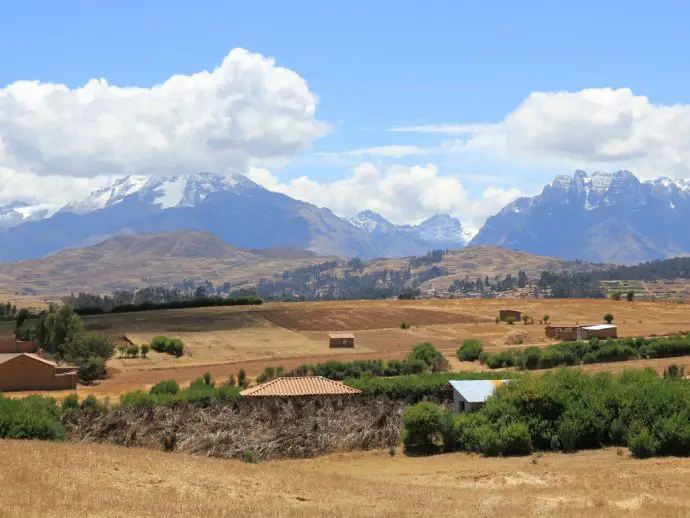
How to get to Chinchero from Cusco
We think the best way to experience the hike, and enjoy exploring the Sacred Valley, is by staying in the area for a few nights, either in Urubamba or one of the surrounding villages as they’re not far from Chinchero. Cusco, however, makes a great base and many people prefer to stay here (and why wouldn’t you, it’s totally charming!), and undertake the Chinchero hike during a day trip.
The best way to travel to Chinchero from Cusco is by colectivo (shared van) or a private taxi. There are buses that travel from Cusco to Urubamba but they’re slower and less comfortable than the colectivos so we don’t really recommend them.
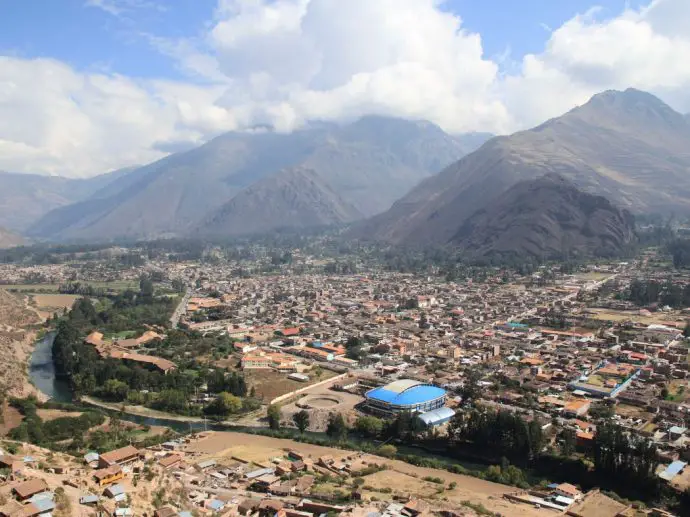
Colectivo
You can easily travel to Chinchero by colectivo (shared taxi) from Cusco. Just make your way to Calle Pavitos and hop on a colectivo heading to Urubamba. Ask the driver to drop you near to the Chinchero ruins, which is where you’ll find the trailhead. You might need to alight at the Chinchero market or plaza, but don’t worry, it’s just a short stroll to the start of the path. Ask for directions to the “Chinchero ruinas” if you’re unsure.
A one-way journey from Cusco to Chinchero should cost around S/.7 per person. When you’ve finished your hike and find yourself in Urquillos, you can hail a colectivo on the main road, and travel to the bus station in Urubamba. From here you can take a bus (or a colectivo) back to Cusco. The price is pretty similar so just pick the one which is going to depart first.
Private Taxi
Private taxis are a great option too, giving you a bit more independence. You can book these through your hotel in Cusco, or just hail one on the street (make sure that it’s licensed). It will set you back about S/.60, or more if you arranging it through a higher end hotel! If you’re heading back to Cusco afterwards, you can arrange for the taxi to pick you up again in Urquillos in a few hours time.
How long is the Chinchero to Urquillos trail
Allow a full day for your Chinchero to Urquillos hike, including travel time from Cusco if required. The walk itself takes around 4 hours, or longer if you keep stopping for photos like we did. The trail is about 5.5 miles in length, and is downhill all the way.
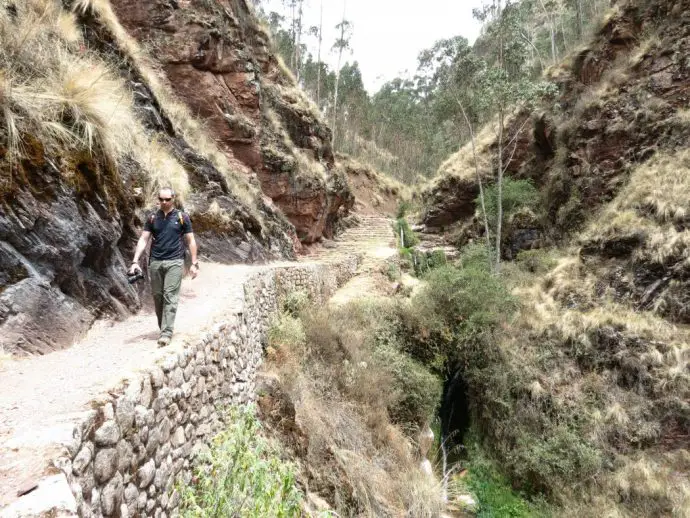
Why visit Chinchero?
The Chinchero weavers
The Incas called Chinchero the birthplace of the rainbow, which is reflected in the colourful fabrics and yarns you’ll see in the marketplace wares. Chinchero textiles are world-renowned, and anyone interesting in learning about the cultural traditions in the Cusco region should visit Chinchero. Perú is well known for its weaving heritage, and there’s no better place to see the experts at work than here on these windswept Andean plains.
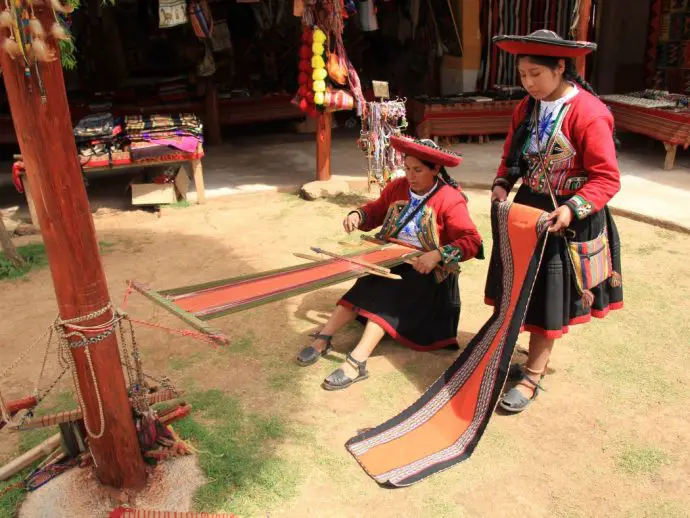
There are plenty of weaving demonstrations at cooperatives across the town, so make sure you pop into one and see what the fuss is all about. The ladies will show you how they wash, dye and spin alpaca wool, and although the demos are free, you can make a donation if you enjoyed the experience.
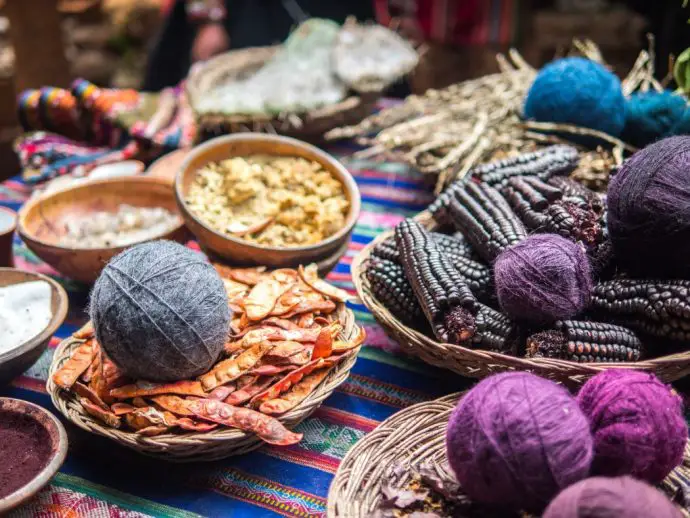
There are of course lots of traditional handicrafts for sale (and many accept major credit cards!), but just remember you’ll have to carry them on your hike!
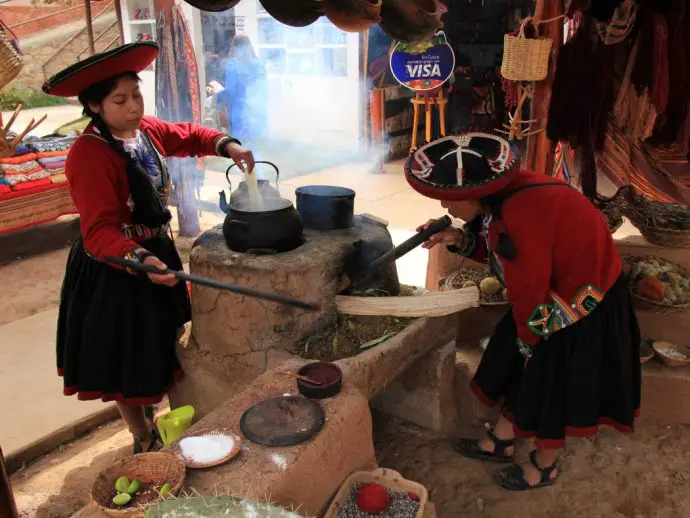
Incas and colonialists
Inca Tupac Yupanqui used Chinchero as his country retreat, which is why you’ll come across so many Inca walls, agricultural terraces, and aqueducts as you wander around the town. Many of them are still being used today. The fertile soil of the terraces is famed for producing superb crops of potatoes and quinoa, much of which is sold at the local Sunday market, which is free to enter if you’re around at the weekend and always a highlight of any Chinchero tour. The archaeological site reminded us of the ruins at Pisac and Ollantaytambo, but the ones here at Chinchero were far quieter.
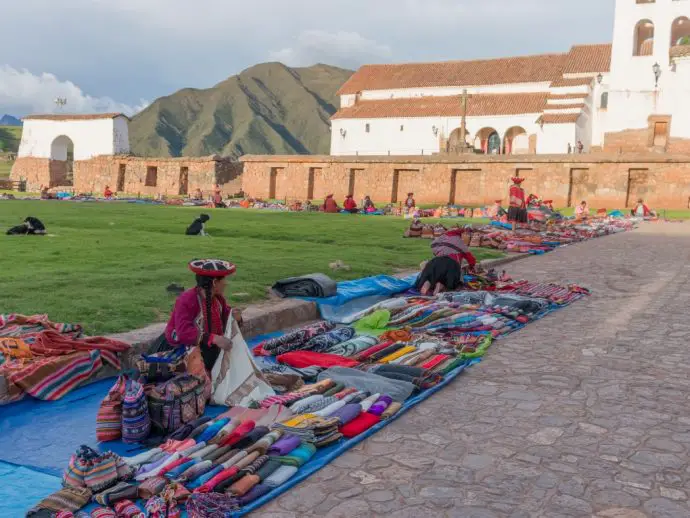
Off the main plaza you’ll find a colonial Spanish church dating back to the early 17th century – the ceiling murals are still vivid today. It was constructed on top of a ruined Incan palace belonging to Inca Tupac himself. You’ll need the Cusco Tourist Ticket if you want to explore the historic centre and the Chinchero ruins. You don’t require a ticket if you simply want to hike the trail.
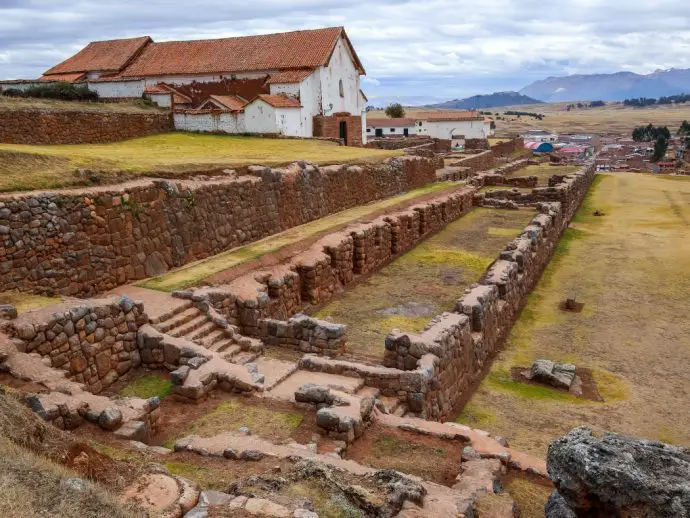
The Chinchero altitude is 3765 metres above sea level, meaning it’s even higher up than Cusco at 3399 metres, so make sure you acclimatise properly before attempting the hike.
Find the trailhead at the Chinchero ruins
You’ll find the trailhead for the Chinchero to Urquillos hike right below the vast terraces of the Chinchero ruins. Locals will point you in the direction of the Chinchero ruinas if you’re struggling to find them. The best views of this archaeological site are probably from here on the trail, so it’s perhaps not worth buying a tourist ticket to explore the site further unless you want to check out the rest of the town.
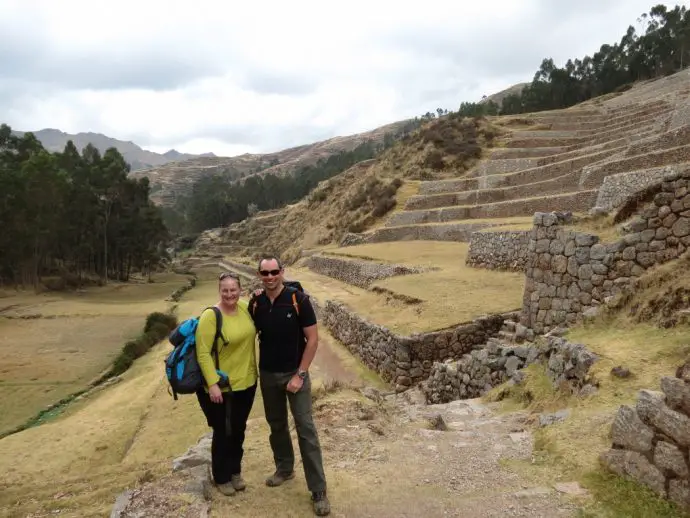
Just follow the path down from the terraces and you’ll soon see a sign announcing the beginning of the Inca trail from Chinchero to Urquillos. It’s called the “Camino Inca Urquillos”. From here, it’s all downhill!
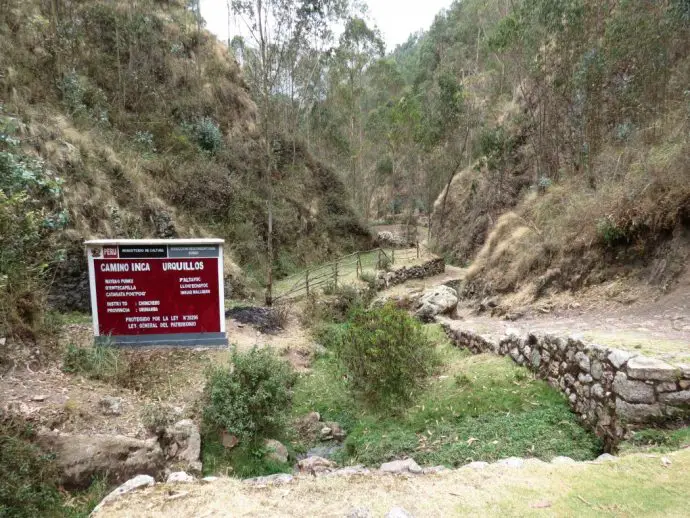
The Chinchero to Urqillos hike
And finally, it’s time to start that hike!
It’s relatively easy to find your way on the Chinchero to Urquillos hike. The path simply winds its way downhill, and you just need to keep following it. There are a few places where you have options to take other trails, but just stick to the main route leading down, and you should be fine.
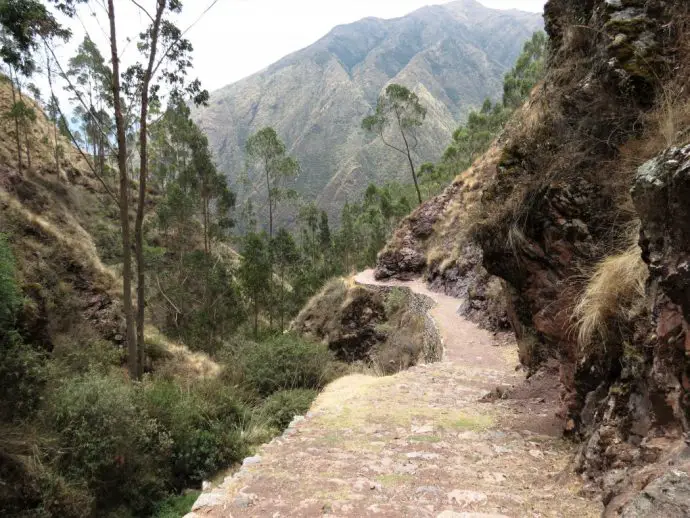
The main thing to know about this walk is that it’s steep. And I mean really steep in some sections. You’ll be descending nearly 1000 metres of elevation, so do pace yourself and look after those knees. The path is in pretty good condition, although we did find the loose gravel sections a little hairy on some of the steep bits.
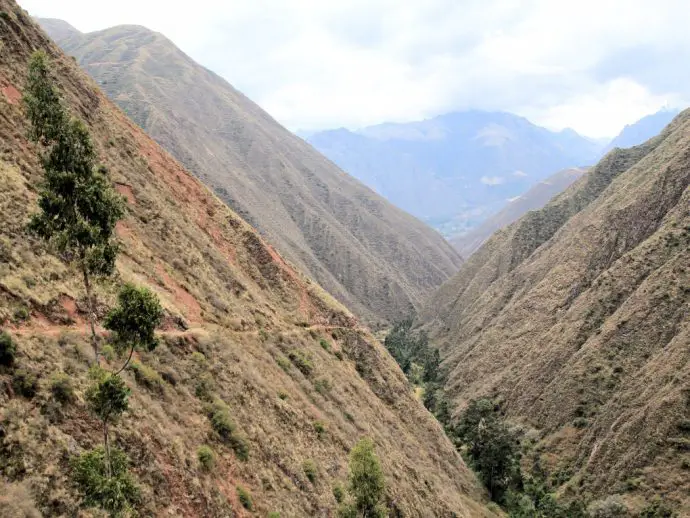
The first part of the trail meanders through forested slopes, following the path of ancient Inca canals that still carry water to irrigate agricultural terraces and fields today.
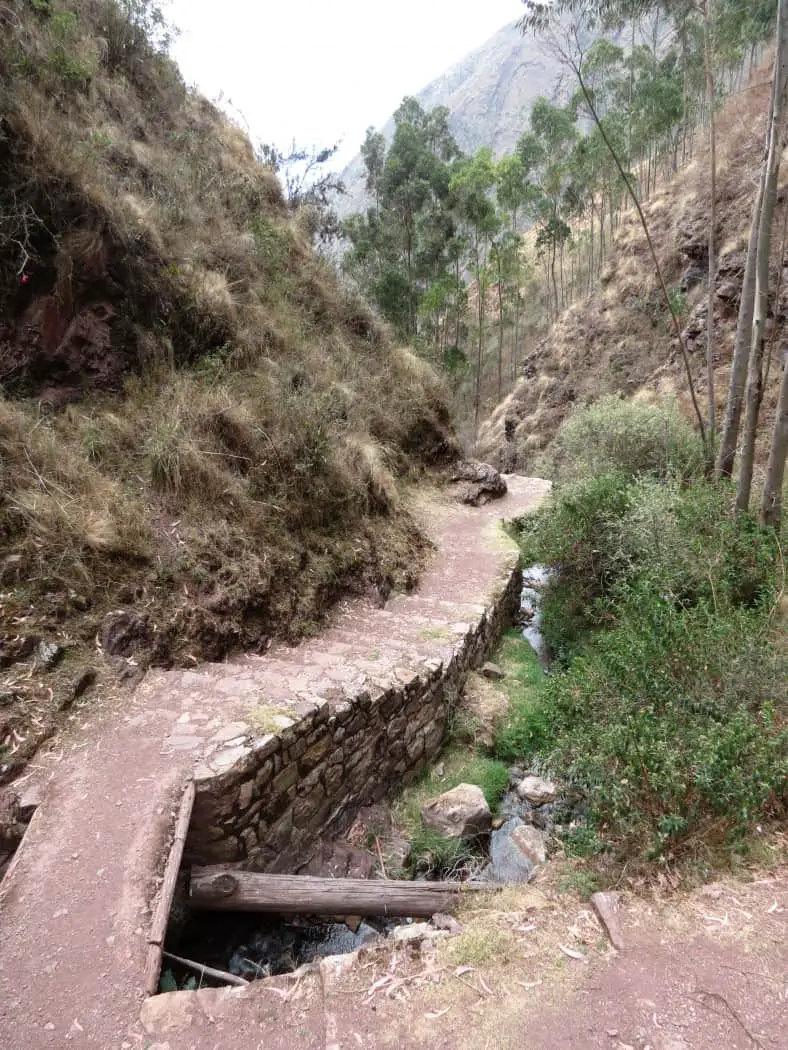
You’ll see plenty of original sections of the ancient Inca trail along the way, and it feels quite exciting to be walking in the footsteps of these revered people.
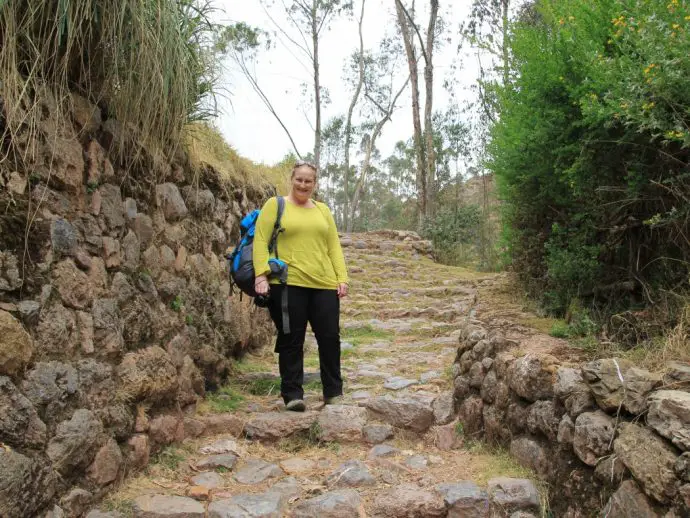
As you emerge from the trees the valley opens up and you’ll enjoy dramatic views down the tranquil canyon towards Urquillos. Never have we seen hillsides as steep (almost vertical!) than here, which made us keep our feet firmly planted on the path.
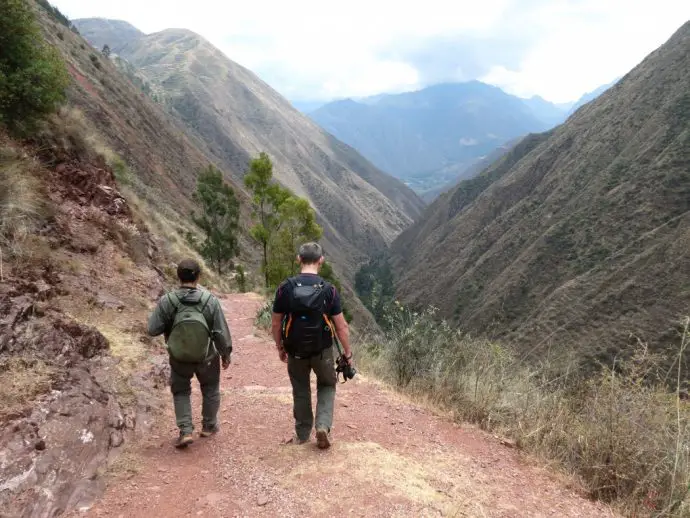
In summer you’ll see carpets of wildflowers (we were there in September after the blooms), and the trickling water from the river down below is ever present. You can veer off the trail and check out the Poc Poc waterfall, but having done a bit of research we decided it really wasn’t worth that extra effort. One false move on the even smaller trail would send you plunging down into the ravine.
The trail continues to wind down through the beautiful valley with stunning views of snow-capped mountains surrounding the Sacred Valley dead ahead. There are plenty of viewpoints for photos, just keep away from the sheer drop at the edge of the trail!
Considering this is a real-life Inca trail, we expected to see more people, but actually, we were the only tourists hiking from Chinchero to Urquillos. This off-the-beaten-track route was super secluded and utterly peaceful, making us feel like we had the Sacred Valley all to ourselves.
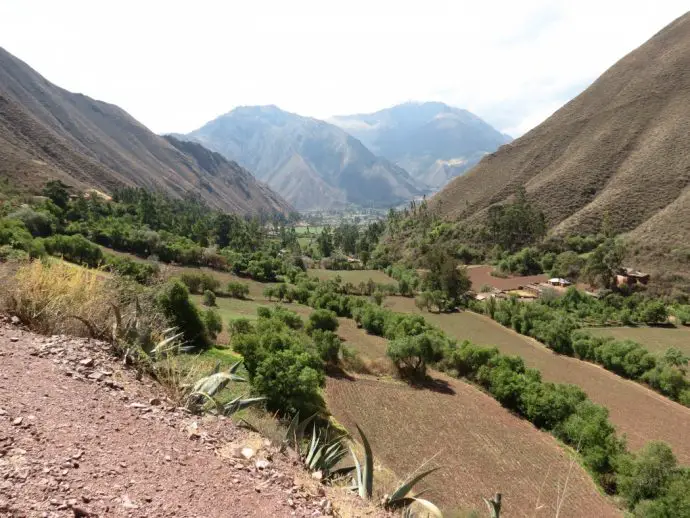
Down towards the bottom of the valley the terrain opens out a bit. We skirted along the river and ambled through fragrant eucalyptus groves before the landscape slowly flattened out to reveal farmland and the charming little village of Urquillos.
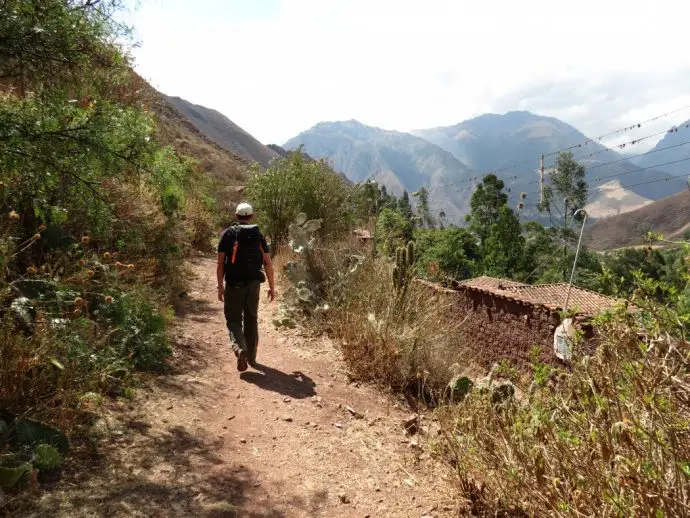
When you finally reach Urquillos, you’ll need to follow the track towards the town centre and the main road, ready for your onward journey by colectivo, or taxi.
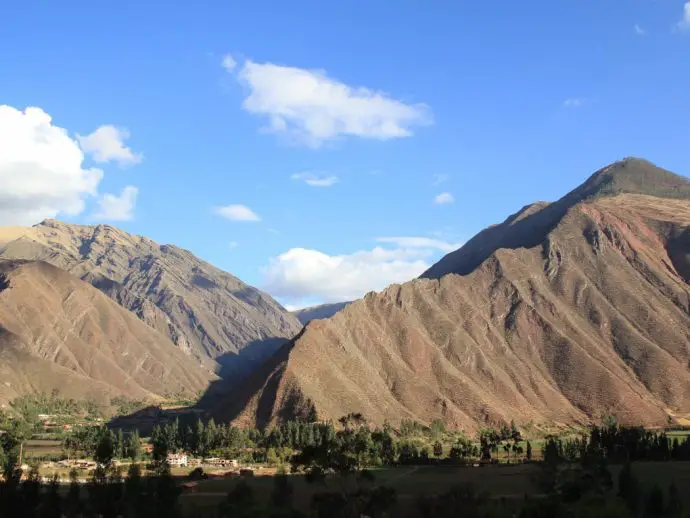
This little-known walk along a remote section of the Inca trail is one of our favourite hikes in Peru, and well worth the effort if you want a break from sacred temples and all those ruins.
So, whilst everyone else is making a beeline for Machu Picchu and Rainbow Mountain, come and do the Chinchero to Urquillos hike and have it all to yourself. We promise you won’t be disappointed.
Go independent or take a private tour
You can easily do the Chinchero to Urquillos hike by yourself, once you’ve arranged transport to the trailhead. Usually, this is what we’d do, since we enjoy our own company and feel quite competent in the mountains. However, on this occasion we actually hired a guide from our Sacred Valley hotel to just make things a bit easier.
There’s something to be said for having an expert local guide accompany you on the trail, and we learnt so much about the environment we were walking through, and saw things that we’d certainly have missed, or not understood, if we’d been alone. It also meant we could just relax and enjoy our surroundings without having the stress of wondering which path to take, or where the best viewpoints for picnics were. If you don’t want to arrange a trip via your hotel, you can always pick up a guide from Chinchero, but just make sure they are properly accredited.
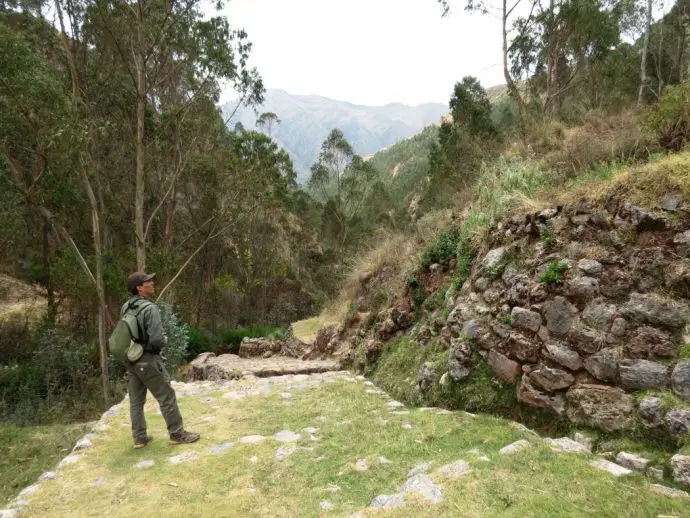
It’s also useful having a guide when you’re exploring the village, making introductions to Chinchero weavers easier, and giving some insider insight into the history of the Chinchero ruins.
So, by all means go it alone. Navigation is easy and the rewards are great. Yet if you want to delve a little deeper into what you’re seeing, then hiring a guide is well worth the extra soles!
When to go
The trail is at its best between May and September, before the snows of winter set in. After heavy rains the path can get muddy, which would be no fun at all considering how steep it is! Even when we visited during September there had been a couple of minor landslides, although the path was still perfectly accessible at that point.
It was fairly overcast during our hike, which made for perfect walking conditions, but during the height of summer just be aware that there’s very little shade after you leave the forests at the start of the trail.
You’ll have an adventure whatever time of year you visit Chinchero. Perú is beautiful in sun, rain, and snow, just make sure you go prepared for the weather conditions you’re likely to face.
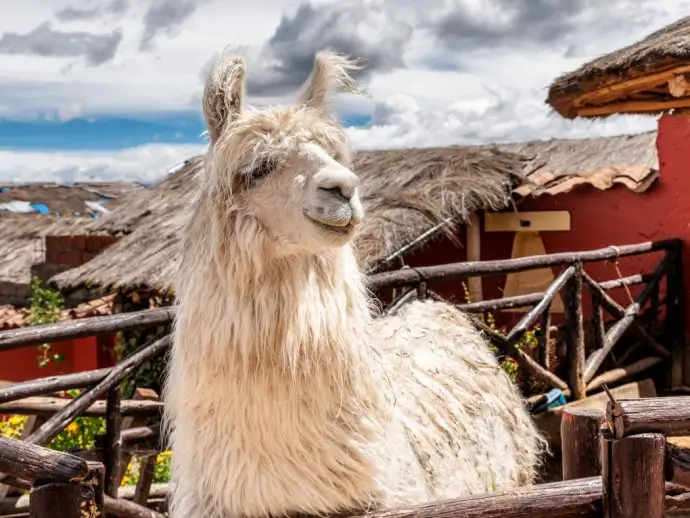
Where to stay in the Sacred Valley
If you want to visit Urubamba, spend longer in the Sacred Valley, or fancy doing a Chinchero tour and want to hike almost directly from your hotel, there are several excellent places to stay near Urquillos.
Luxury hotels
We opted for the Inkaterra Hacienda Urubamba, having enjoyed stays at most of the other Inkaterra properties including La Casona in Cusco, Reserva Amazonia in Tambopata (where we slept in a treehouse!), and their super stylish Machu Picchu Pueblo Hotel. The Hacienda Urubamba is a modern and super sumptuous farmhouse-style hotel in the heart of the Sacred Valley, with incredible views in all directions.
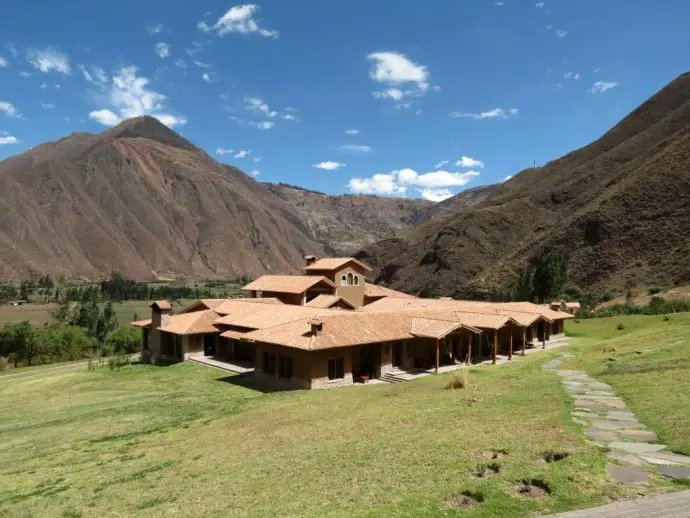
Surrounded by towering peaks and green fields, it’s the sort of place where your camera will be working in overdrive. The bedrooms are independent, luxurious casitas dotted around the grounds and the main building with its floor-to-ceiling picture windows is where you’ll enjoy meals. It was actually one of our favourite places to stay in Peru, and anyone who loves luxury and nature will do well staying a few nights here.
Other options include the well-regarded Explora Lodge, which blends minimalist, Scandi-style design with the natural environment, and the opulent Sol y Luna by Relais and Chateaux just up the valley in Urubamba. There’s also Tambo del Inka which is more contemporary in style and has an excellent spa.
Mid-range hotels
With modern conveniences in an 18th-century setting, the Hotel La Casona de Yucay is a great choice. The views are outstanding and the grounds are lush. Head over to Casa Andina for chalet-style accommodation and great Andean panoramas. They have a spa and a planetarium for extra bonus points. The Tierra Viva Valle Sagrado Hotel has been designed to remind you of the architecture in Cusco, and rooms have private terraces or balconies so you can soak up those views.
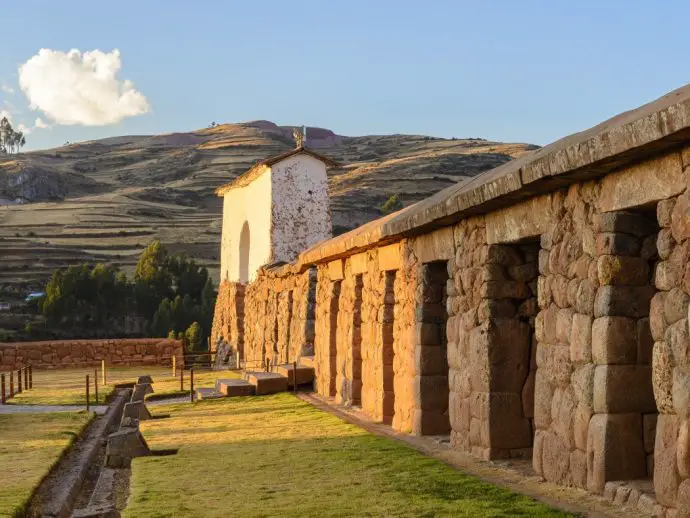
Top tips for hiking the Chinchero to Urquillos trail
- Sturdy hiking boots are a must on this steep, downhill mountain trail.
- If you have problems with your knees, this might not be for you. I do, and could hardly walk by the time I reached the bottom. The views were worth the pain though! Pack a walking pole if it helps.
- Take plenty of water. There’s little shade on the trail once you emerge from the upper section.
- Sunscreen is a must on hot days.
- If you’re hiking independently, make sure you have downloaded a map as there’s no mobile phone reception in the valley.
- Allow yourself a couple of days to acclimatise in Cusco before attempting this trail due to the high altitude.
- If you want to purchase any Chinchero textiles at the market, remember you’ll have to carry them with you on the trail!

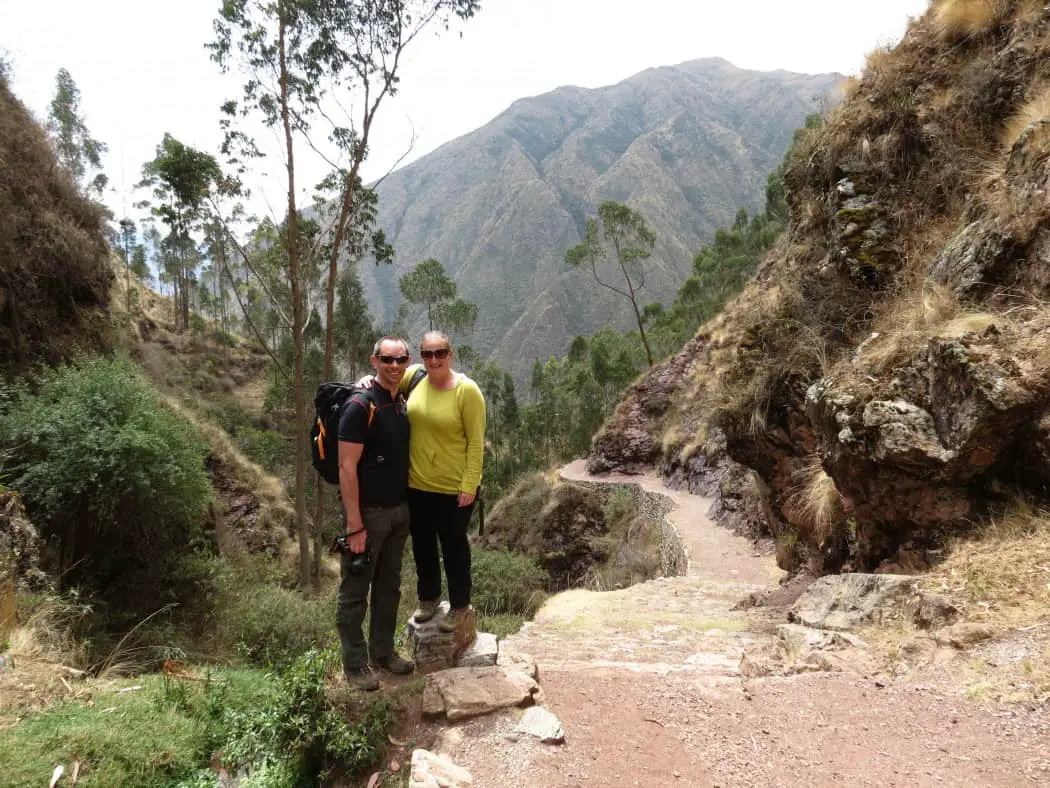
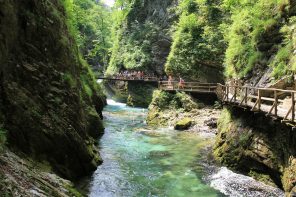
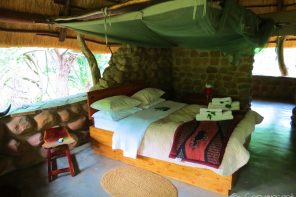
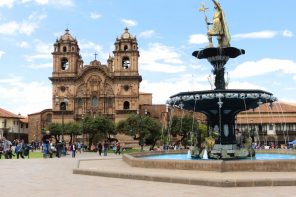
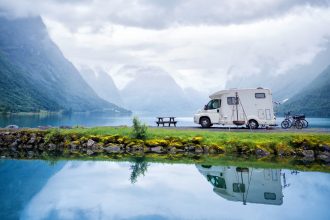
Thanks for this guide! I was wondering, to access the trialhead do we need to pay and enter the ruins to find the start of the trial?
Hi Stella, no, there’s no need to actually enter the ruins (or pay) to access the trailhead.